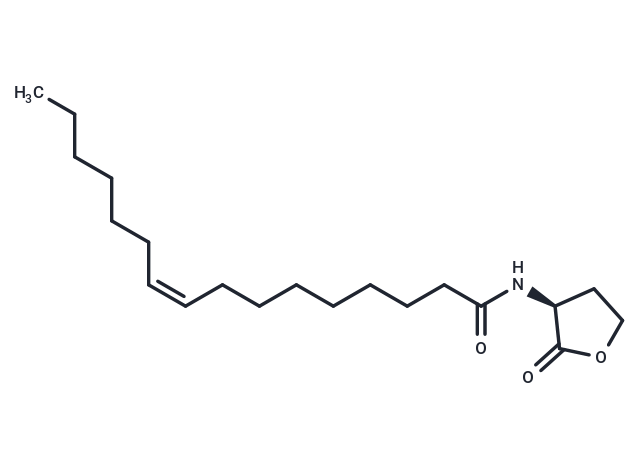 Your shopping cart is currently empty
Your shopping cart is currently empty

Quorum sensing is a regulatory process used by bacteria for controlling gene expression in response to increasing cell density.[1] This regulatory process manifests itself with a variety of phenotypes including biofilm formation and virulence factor production.[2] Coordinated gene expression is achieved by the production, release, and detection of small diffusible signal molecules called autoinducers. The N-acylated homoserine lactones (AHLs) comprise one such class of autoinducers, each of which generally consists of a fatty acid coupled with homoserine lactone (HSL). AHLs vary in acyl group length (C4-C18), in the substitution of C3 (hydrogen, hydroxyl, or oxo group) and in the presence or absence of one or more carbon-carbon double bonds in the fatty acid chain. These differences confer signal specificity through the affinity of transcriptional regulators of the LuxR family.[3] C16:1-Δ9-(L)-HSL is a long-chain AHL that functions as a quorum sensing signaling molecule in strains of S. meliloti.[4],[5],[6],[7] Regulating bacterial quorum sensing signaling can be used to inhibit pathogenesis and thus, represents a new approach to antimicrobial therapy in the treatment of infectious diseases.[8]

| Pack Size | Price | USA Warehouse | Global Warehouse | Quantity |
|---|---|---|---|---|
| 5 mg | $159 | 35 days | 35 days | |
| 10 mg | $297 | 35 days | 35 days | |
| 25 mg | $686 | 35 days | 35 days | |
| 50 mg | $1,230 | 35 days | 35 days |
| Description | Quorum sensing is a regulatory process used by bacteria for controlling gene expression in response to increasing cell density.[1] This regulatory process manifests itself with a variety of phenotypes including biofilm formation and virulence factor production.[2] Coordinated gene expression is achieved by the production, release, and detection of small diffusible signal molecules called autoinducers. The N-acylated homoserine lactones (AHLs) comprise one such class of autoinducers, each of which generally consists of a fatty acid coupled with homoserine lactone (HSL). AHLs vary in acyl group length (C4-C18), in the substitution of C3 (hydrogen, hydroxyl, or oxo group) and in the presence or absence of one or more carbon-carbon double bonds in the fatty acid chain. These differences confer signal specificity through the affinity of transcriptional regulators of the LuxR family.[3] C16:1-Δ9-(L)-HSL is a long-chain AHL that functions as a quorum sensing signaling molecule in strains of S. meliloti.[4],[5],[6],[7] Regulating bacterial quorum sensing signaling can be used to inhibit pathogenesis and thus, represents a new approach to antimicrobial therapy in the treatment of infectious diseases.[8] |
| Synonyms | N-cis-hexadec-9Z-enoyl-L-Homoserine lactone, N-(2-oxotetrahydrofuran-3S-yl) Palmitoleyl Amide |
| Molecular Weight | 337.504 |
| Formula | C20H35NO3 |
| Cas No. | 479050-94-7 |
| Smiles | CCCCCC\C=C/CCCCCCCC(=O)N[C@H]1CCOC1=O |
| Relative Density. | no data available |
| Storage | Powder: -20°C for 3 years | In solvent: -80°C for 1 year | Shipping with blue ice/Shipping at ambient temperature. | ||||||||||||||||||||||||||||||
| Solubility Information | DMF: 20 mg/mL (59.26 mM), Sonication is recommended. DMSO: 20 mg/mL (59.26 mM), Sonication is recommended. | ||||||||||||||||||||||||||||||
Solution Preparation Table | |||||||||||||||||||||||||||||||
DMF/DMSO
| |||||||||||||||||||||||||||||||
| Size | Quantity | Unit Price | Amount | Operation |
|---|

Copyright © 2015-2026 TargetMol Chemicals Inc. All Rights Reserved.